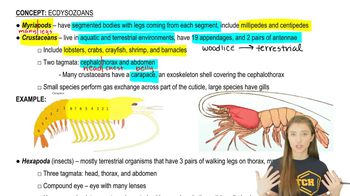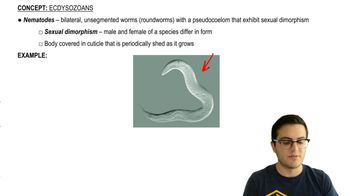Table of contents
- 1. Introduction to Biology2h 42m
- 2. Chemistry3h 40m
- 3. Water1h 26m
- 4. Biomolecules2h 23m
- 5. Cell Components2h 26m
- 6. The Membrane2h 31m
- 7. Energy and Metabolism2h 0m
- 8. Respiration2h 40m
- 9. Photosynthesis2h 49m
- 10. Cell Signaling59m
- 11. Cell Division2h 47m
- 12. Meiosis2h 0m
- 13. Mendelian Genetics4h 44m
- Introduction to Mendel's Experiments7m
- Genotype vs. Phenotype17m
- Punnett Squares13m
- Mendel's Experiments26m
- Mendel's Laws18m
- Monohybrid Crosses19m
- Test Crosses14m
- Dihybrid Crosses20m
- Punnett Square Probability26m
- Incomplete Dominance vs. Codominance20m
- Epistasis7m
- Non-Mendelian Genetics12m
- Pedigrees6m
- Autosomal Inheritance21m
- Sex-Linked Inheritance43m
- X-Inactivation9m
- 14. DNA Synthesis2h 27m
- 15. Gene Expression3h 20m
- 16. Regulation of Expression3h 31m
- Introduction to Regulation of Gene Expression13m
- Prokaryotic Gene Regulation via Operons27m
- The Lac Operon21m
- Glucose's Impact on Lac Operon25m
- The Trp Operon20m
- Review of the Lac Operon & Trp Operon11m
- Introduction to Eukaryotic Gene Regulation9m
- Eukaryotic Chromatin Modifications16m
- Eukaryotic Transcriptional Control22m
- Eukaryotic Post-Transcriptional Regulation28m
- Eukaryotic Post-Translational Regulation13m
- 17. Viruses37m
- 18. Biotechnology2h 58m
- 19. Genomics17m
- 20. Development1h 5m
- 21. Evolution3h 1m
- 22. Evolution of Populations3h 52m
- 23. Speciation1h 37m
- 24. History of Life on Earth2h 6m
- 25. Phylogeny2h 31m
- 26. Prokaryotes4h 59m
- 27. Protists1h 12m
- 28. Plants1h 22m
- 29. Fungi36m
- 30. Overview of Animals34m
- 31. Invertebrates1h 2m
- 32. Vertebrates50m
- 33. Plant Anatomy1h 3m
- 34. Vascular Plant Transport1h 2m
- 35. Soil37m
- 36. Plant Reproduction47m
- 37. Plant Sensation and Response1h 9m
- 38. Animal Form and Function1h 19m
- 39. Digestive System1h 10m
- 40. Circulatory System1h 57m
- 41. Immune System1h 12m
- 42. Osmoregulation and Excretion50m
- 43. Endocrine System1h 4m
- 44. Animal Reproduction1h 2m
- 45. Nervous System1h 55m
- 46. Sensory Systems46m
- 47. Muscle Systems23m
- 48. Ecology3h 11m
- Introduction to Ecology20m
- Biogeography14m
- Earth's Climate Patterns50m
- Introduction to Terrestrial Biomes10m
- Terrestrial Biomes: Near Equator13m
- Terrestrial Biomes: Temperate Regions10m
- Terrestrial Biomes: Northern Regions15m
- Introduction to Aquatic Biomes27m
- Freshwater Aquatic Biomes14m
- Marine Aquatic Biomes13m
- 49. Animal Behavior28m
- 50. Population Ecology3h 41m
- Introduction to Population Ecology28m
- Population Sampling Methods23m
- Life History12m
- Population Demography17m
- Factors Limiting Population Growth14m
- Introduction to Population Growth Models22m
- Linear Population Growth6m
- Exponential Population Growth29m
- Logistic Population Growth32m
- r/K Selection10m
- The Human Population22m
- 51. Community Ecology2h 46m
- Introduction to Community Ecology2m
- Introduction to Community Interactions9m
- Community Interactions: Competition (-/-)38m
- Community Interactions: Exploitation (+/-)23m
- Community Interactions: Mutualism (+/+) & Commensalism (+/0)9m
- Community Structure35m
- Community Dynamics26m
- Geographic Impact on Communities21m
- 52. Ecosystems2h 36m
- 53. Conservation Biology24m
31. Invertebrates
Ecdysozoans
Problem 11a`
Textbook Question
A team of 102 scientists spent a year surveying a small area of the San Lorenzo rain forest in Panama to count the number of species of arthropods living there. After collecting 129,494 specimens—using nets, traps, shovels, tree-climbing harnesses, helium balloons, and other creative gear—it took the team eight years to sort and identify the arthropods. Which of the following nested groups best describes the taxonomic context for the San Lorenzo project?
a. Animalia > Bilateria > Arthropoda > Ecdysozoa
b. Protostomia > Lophotrochozoa > Ecdysozoa > Arthropoda
c. Arthropoda > Protostomia > Ecdysozoa > Bilateria
d. Bilateria > Protostomia > Ecdysozoa > Arthropoda
 Verified step by step guidance
Verified step by step guidance1
Step 1: Begin by understanding the taxonomic hierarchy. Taxonomy is the classification of organisms into nested groups based on shared characteristics. The major taxonomic ranks include Domain, Kingdom, Phylum, Class, Order, Family, Genus, and Species. In this problem, we are dealing with higher-level groupings such as Animalia, Bilateria, Protostomia, Ecdysozoa, and Arthropoda.
Step 2: Identify the organism group in question. Arthropods are invertebrates with segmented bodies, exoskeletons made of chitin, and jointed appendages. Examples include insects, spiders, and crustaceans. Arthropods belong to the Kingdom Animalia.
Step 3: Determine the nested groups leading to Arthropoda. Arthropods are part of the Bilateria, a group of animals with bilateral symmetry. Within Bilateria, they belong to Protostomia, which includes animals that develop the mouth before the anus during embryonic development. Protostomia is further divided into Lophotrochozoa and Ecdysozoa, with Arthropoda falling under Ecdysozoa (organisms that molt their exoskeleton).
Step 4: Analyze the options provided. The correct sequence should reflect the taxonomic hierarchy from broader to more specific groups: Kingdom Animalia > Bilateria > Protostomia > Ecdysozoa > Arthropoda.
Step 5: Match the correct sequence to the options. Based on the hierarchy, the correct nested group is: d. Bilateria > Protostomia > Ecdysozoa > Arthropoda.
 Verified video answer for a similar problem:
Verified video answer for a similar problem:This video solution was recommended by our tutors as helpful for the problem above
Video duration:
1mPlay a video:
Was this helpful?
Key Concepts
Here are the essential concepts you must grasp in order to answer the question correctly.
Taxonomy
Taxonomy is the science of classifying organisms into hierarchical categories based on shared characteristics. It involves grouping species into nested categories such as domain, kingdom, phylum, class, order, family, genus, and species. Understanding taxonomy is crucial for identifying the relationships between different organisms, which is essential for answering questions about biodiversity, such as the one posed in the San Lorenzo project.
Recommended video:
Guided course

Introduction to Taxonomy
Phylogenetic Relationships
Phylogenetic relationships refer to the evolutionary connections between different species or groups of organisms. These relationships are often depicted in phylogenetic trees, which illustrate how species have diverged from common ancestors over time. Recognizing these relationships helps in understanding the evolutionary history of the arthropods surveyed in the San Lorenzo rainforest and aids in selecting the correct nested group for classification.
Recommended video:

Building Phylogenetic Trees Example 2
Ecdysozoa
Ecdysozoa is a clade of animals characterized by their ability to molt, or shed their exoskeleton, as they grow. This group includes arthropods, nematodes, and several other phyla. Understanding the characteristics of Ecdysozoa is important for classifying the arthropods found in the San Lorenzo rainforest, as it helps to place them within the broader context of animal evolution and diversity.
Recommended video:
Guided course

Arthropods and Chelicerata

 8:01m
8:01mWatch next
Master Arthropods and Chelicerata with a bite sized video explanation from Jason
Start learningRelated Videos
Related Practice











